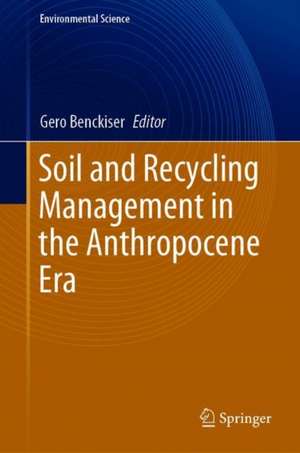Soil and Recycling Management in the Anthropocene Era: Environmental Science and Engineering
Editat de Gero Benckiseren Limba Engleză Hardback – 16 mar 2021
| Toate formatele și edițiile | Preț | Express |
|---|---|---|
| Paperback (1) | 578.70 lei 6-8 săpt. | |
| Springer International Publishing – 17 mar 2022 | 578.70 lei 6-8 săpt. | |
| Hardback (1) | 641.38 lei 6-8 săpt. | |
| Springer International Publishing – 16 mar 2021 | 641.38 lei 6-8 săpt. |
Din seria Environmental Science and Engineering
- 18%
 Preț: 1238.42 lei
Preț: 1238.42 lei - 18%
 Preț: 2166.68 lei
Preț: 2166.68 lei - 18%
 Preț: 1420.88 lei
Preț: 1420.88 lei - 18%
 Preț: 914.20 lei
Preț: 914.20 lei - 18%
 Preț: 1225.94 lei
Preț: 1225.94 lei - 18%
 Preț: 1118.13 lei
Preț: 1118.13 lei - 18%
 Preț: 1402.74 lei
Preț: 1402.74 lei - 18%
 Preț: 3419.93 lei
Preț: 3419.93 lei - 18%
 Preț: 1223.55 lei
Preț: 1223.55 lei - 18%
 Preț: 1008.91 lei
Preț: 1008.91 lei - 18%
 Preț: 1234.46 lei
Preț: 1234.46 lei - 18%
 Preț: 1409.82 lei
Preț: 1409.82 lei - 18%
 Preț: 736.64 lei
Preț: 736.64 lei - 18%
 Preț: 949.73 lei
Preț: 949.73 lei - 18%
 Preț: 1287.47 lei
Preț: 1287.47 lei - 18%
 Preț: 2116.64 lei
Preț: 2116.64 lei - 18%
 Preț: 1231.95 lei
Preț: 1231.95 lei - 15%
 Preț: 641.71 lei
Preț: 641.71 lei - 23%
 Preț: 1129.32 lei
Preț: 1129.32 lei - 18%
 Preț: 1237.93 lei
Preț: 1237.93 lei - 18%
 Preț: 956.18 lei
Preț: 956.18 lei - 24%
 Preț: 1057.94 lei
Preț: 1057.94 lei - 24%
 Preț: 1079.09 lei
Preț: 1079.09 lei - 18%
 Preț: 953.03 lei
Preț: 953.03 lei - 18%
 Preț: 1233.06 lei
Preț: 1233.06 lei - 15%
 Preț: 666.73 lei
Preț: 666.73 lei - 18%
 Preț: 1222.31 lei
Preț: 1222.31 lei - 18%
 Preț: 1242.35 lei
Preț: 1242.35 lei - 18%
 Preț: 1232.89 lei
Preț: 1232.89 lei - 18%
 Preț: 1823.56 lei
Preț: 1823.56 lei - 18%
 Preț: 1228.96 lei
Preț: 1228.96 lei - 18%
 Preț: 1221.69 lei
Preț: 1221.69 lei - 18%
 Preț: 945.79 lei
Preț: 945.79 lei - 18%
 Preț: 1008.28 lei
Preț: 1008.28 lei - 24%
 Preț: 795.50 lei
Preț: 795.50 lei - 18%
 Preț: 1246.47 lei
Preț: 1246.47 lei - 18%
 Preț: 1239.85 lei
Preț: 1239.85 lei - 18%
 Preț: 957.62 lei
Preț: 957.62 lei - 18%
 Preț: 1244.89 lei
Preț: 1244.89 lei - 15%
 Preț: 640.55 lei
Preț: 640.55 lei - 18%
 Preț: 950.33 lei
Preț: 950.33 lei - 18%
 Preț: 1824.01 lei
Preț: 1824.01 lei - 15%
 Preț: 639.59 lei
Preț: 639.59 lei - 18%
 Preț: 947.50 lei
Preț: 947.50 lei - 18%
 Preț: 951.29 lei
Preț: 951.29 lei - 18%
 Preț: 1229.73 lei
Preț: 1229.73 lei
Preț: 641.38 lei
Preț vechi: 754.56 lei
-15% Nou
Puncte Express: 962
Preț estimativ în valută:
122.74€ • 133.28$ • 103.10£
122.74€ • 133.28$ • 103.10£
Carte tipărită la comandă
Livrare economică 22 aprilie-06 mai
Preluare comenzi: 021 569.72.76
Specificații
ISBN-13: 9783030518851
ISBN-10: 303051885X
Pagini: 172
Ilustrații: XV, 172 p. 36 illus., 21 illus. in color.
Dimensiuni: 155 x 235 mm
Greutate: 0.45 kg
Ediția:1st ed. 2021
Editura: Springer International Publishing
Colecția Springer
Seriile Environmental Science and Engineering, Environmental Science
Locul publicării:Cham, Switzerland
ISBN-10: 303051885X
Pagini: 172
Ilustrații: XV, 172 p. 36 illus., 21 illus. in color.
Dimensiuni: 155 x 235 mm
Greutate: 0.45 kg
Ediția:1st ed. 2021
Editura: Springer International Publishing
Colecția Springer
Seriile Environmental Science and Engineering, Environmental Science
Locul publicării:Cham, Switzerland
Cuprins
1) Soil profiles, the memory of pre-Anthropocene environmental and climate events
2) The anthropogenic environment and climate shaping
3) The soil pore system and physicochemical, biological stabilization forces
4) The soil faunal role in soil structuring and population control
5) N-availability-dependent microflora changes and their influences on matter conversion
5.1. The aquatic and terrestrial virome and cell multiplication regulation
5.2. Bacterial and archaeal metagenome changes through N over-fertilization in upland soils
5.3. The metagenome of paddy soils and changes through related management efforts
5.4. The fungal soil metagenome and its function
5.5. The protozoan soil metagenome and bacterial multiplication regulation
6) Synthetic biology: breeding, health, and soil recycling aspects
7) Wastewater treatment approaches in solving recycling problems
8) Organic, precision farming approaches for achieving plant-demand-adapted fertilization
Textul de pe ultima copertă
This book discusses soil and recycling management in the Anthropocene era. Nitrogen shortage is one of nature’s most important productivity regulators, but since the advent of technical nitrogen fixation (TNF), biological nitrogen fixation (BNF) input has nearly doubled, particularly in grass and arable lands covering over 13 million km2 of the Earth’s surface. This book explores how monoculture grass, arable lands and forests are often over fertilized with TNF, animal slurries, sewage sludge, or municipally produced composts, and as a result, flora and fauna that have adapted to a nitrogen shortage in the soil will have to adjust to a surplus; those that are unable to adapt will disappear.
Caracteristici
Discusses the physicochemistry and biology of soils Describes how soils serve as historical records Provides organic and precision farming approaches for achieving plant demand-adapted fertilization
